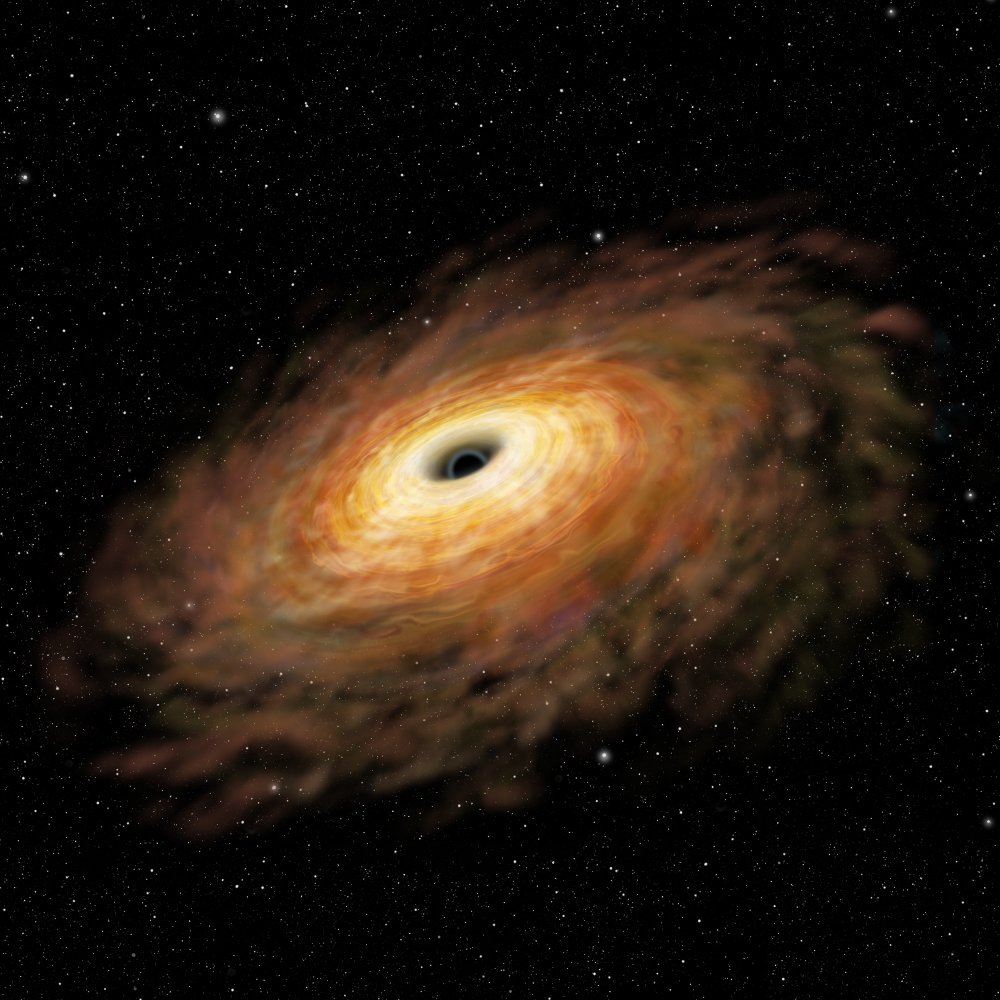MessageToEagle.com – Supermassive black holes are the most destructive force in the Universe, with a compact energy source of enormous strength and a mass of an order of magnitude between 105 and 1010 (hundreds of thousands and tens of billions) of solar masses!
A black hole is a special region of space from which no matter or radiation can escape. A black hole is a result of the extreme curvature of space by a massive compact body. However, black holes can never be observed directly and their existence can only be inferred from the gravitational effects and the radiation emitted by material falling into them.
The supermassive black holes are so bizarre that until recently scientists did not believe they existed.

But they do exist and are believed to be the engines that power nuclear activity in galaxies.
They are dangerous; they could fill a whole solar system! It’s a power of unbelievable proportions that causes space time distortions. Black holes alter spacetime.
A few years ago, NASA scientists using the Swift satellite conducted the first all-sky survey and gathered more than 200 supermassive black holes (Active Galactic Nuclei, or AGN) in the local universe.
“We are confident that we are seeing every active, supermassive black hole within 400 million light years of Earth,” said Jack Tueller of NASA’s Goddard Space Flight Center, Greenbelt, Md., who led the effort.
Recently, astronomers of University of California, Berkeley, have discovered the largest black holes to date – two monsters with masses equivalent to 10 billion suns that are threatening to consume anything, even light, within a region five times the size of our solar system.
These black holes are at the centers of two galaxies more than 300 million light years from Earth
To date, approximately 63 supermassive black holes have been found lurking in the cores of nearby galaxies.
See also:
The largest for more than three decades was a 6.3 billion solar mass black hole in the center of the nearby galaxy M87.
They produce energy from matter extremely efficiently.
According to astronomical calculations, matter that falls into a black hole can emit an amount of energy equivalent to converting as much as 30% of its mass into energy!
Just think about it, for comparison, nuclear fusion converts less than 1% of the masses of nuclei into energy.
With the exception of supermassive black holes, nothing seems capable of producing such tremendous amount of energy.
Astronomers think that the cores of virtually every galaxy contain a supermassive black hole of a million solar masses or more. Our Milky Way also has one, Sagittarius A (Sgr A ), the most energetic object in the Milky Way about with about 4.3 million solar masses. Compared to other black holes of similar size, Sgr A was rather dormant – until recently.
The fuel for this black hole comes from powerful winds blown off dozens of massive young stars that are concentrated nearby. These stars are located a relatively large distance away from Sgr A*, where the gravity of the black hole is weak, and so their high-velocity winds are difficult for the black hole to capture and swallow. Scientists have previously calculated that Sgr A* should consume only about 1% of the fuel carried in the winds. Credits: Chandra X-ray Observatory
Since 2002, astronomers observed the black hole’s quiet neighborhood through the Very Large Telescope. Now, Sagittarius A wakes up. A dusty gas cloud, three times the mass of Earth, and with a highly eccentric orbit, is falling into the accretion zone of our black hole. It will be closest to the black hole in 2013 with a distance of 40 billion kilometers.
For the next few years the cloud will be consumed by our black hole. Nothing can escape a black hole’s gravity, not even light.
“The event will become much more dramatic in the near future … the cloud now accelerates quickly towards the massive black hole,” Stefan Gillessen, an astronomer at the Max Planck Institute for Extraterrestrial Physics in Garching, Germany said.
“Only two stars so far have come that close to the black hole since we started our observations in 1992,” says Stefan Gillessen.
“The stars passed unharmed through their closest approach; the crucial difference to them is that the gas cloud will be completely ripped apart by the tidal forces around the black hole.”
The cloud is expected to break up in 2013.
Only a few percent of these black holes appear to be active and violent consumers of all possible matter around them. Naturally, there is no instance in which a black hole actually has been observed in the center of a galaxy.
They emit no radiation, therefore no direct detection of a remote black hole is possible, only its great gravitational influence can be detected.
What happens when two supermassive monster black holes move dangerously close to each other and collide?
Nobody has witnessed a collision of black holes yet, but such extremely violent cosmic event should generate gravity waves of sufficient amplitude to detect on earth.
The Columbia Supercomputer at NASA’s Advanced Supercomputing Facility at Ames Research Center has performed a series of simulations of gravitational waves.
Laser interferometric detectors, such as LIGO, GEO600 and Virgo are the most sophisticated black hole hunters detecting gravitational waves!
Their goal is to seeks ripples in the fabric of space and time.
Copyright © MessageToEagle.com All rights reserved. This material may not be published, broadcast, rewritten or redistributed in whole or part without the express written permission of MessageToEagle.com
Expand for references





